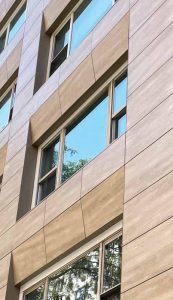
The architects were convinced a rainscreen system was the solution to address all the challenges presented. They proposed a cost-effective porcelain tile cladding material fastened with exposed clips. Zoning regulations permitted a 101.6-mm (4-in.) encroachment over the property line; this enabled them to expand the width of the exterior wall with the retrofit to allow room for a high-performance assembly, designed to meet Passive House standards for the solid wall portion of the facade. When it came to materials for the new building envelope, stone wool insulation was the first choice, primarily because of its superior fire-resilient properties, as well as its ability to deliver thermal performance and comfort.
Rigid stone wool insulation boards—both unfaced and with the matte black fleece layer—were specified for the project. The building’s new facade used an open-joint system, requiring the assembly materials to meet needs for aesthetics, durability, and energy efficiency. Where the insulating material is visible in these open-joint systems, the stone wool insulation boards with the matte black layer do not detract from the design. Further, both stone wool products provide exceptional moisture resistance and drying properties, making them an ideal component for rainscreen systems.
The metal framing for the new cladding was bolted into the original concrete block backing (now repaired and sealed with a liquid-applied membrane) and the stone wool boards were quickly and efficiently installed behind the framing. Around the windows, the architects designed a custom beveled-edge system to accommodate the new envelope assembly for airtightness and still allow for the window units to be replaced and resealed at a later time.
Stone wool is easy to cut, enabling crews to trim the material to fit with the inconsistent detailing and spacing around original and newer window installations. The last stage of the assembly was attaching the porcelain tiles with an innovative clip system; the non-combustible tiles were an important component of the fire-resilient design of the entire assembly.
“We chose to specify rigid stone wool insulation boards for this project because it met so many of our needs, and there were a lot of them,” says Alissa Bucher of Rogers Partners Architects + Urban Design. “The rainscreen assembly needed an insulation material that would deliver on thermal performance, fire protection, acoustics, and of course, durability. It also needed to work with the design of the unique porcelain tile we chose for the facade. Stone wool was the go-to material. Four inches [101.6 mm] of stone wool in these walls will help ensure the new exterior will stand the test of time.”
Complete solution for open-joint systems
The move towards open-joint rainscreens means the joints between the cladding elements are intentionally left open, principally to provide superior drying potential, and with the added benefit of greater flexibility in designing the structure’s exterior aesthetics. Innovations such as black fleece-faced insulation boards show there is no need to compromise the system’s performance in order to achieve good aesthetics. An open-joint cladding provides optimum protection against the impact of water when the system is designed with proper drainage and ventilation. Additionally, since stone wool insulation products are hydrophobic in nature, they repel water and resist rot and mold. If water does enter the insulation from snow or wind-driven rain, it can dry out due to the higher drying potential of stone wool—making it an ideal choice for
open-joint rainscreens.
 Author
Author
Brendan Van Gool is the product marketing manager for building insulation at Rockwool, a global stone wool manufacturer with five facilities in North America. Van Gool has been with the company for more than six years, providing knowledge and experience in areas of product management, technical services, customer relations, and marketing and business development.




